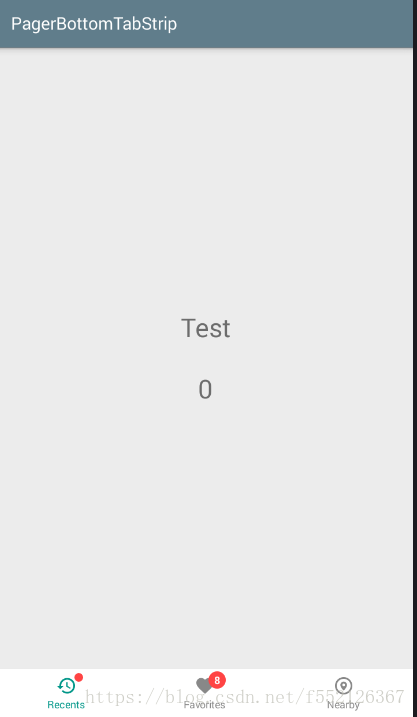PagerBottomTabStrip 是一个基本按谷歌Material Design规范完成的安卓底部导航栏控件
官方设计规范:https://www.google.com/design/spec/components/bottom-navigation.html
1、前言
(1)底部选择菜单功能应该是大多app都会用到的,实现方式也有很多种,比较笨的方法可以自定义一个xml,下方布局样式,每次点击不同按钮时跳转到不同activity,这个activity重新加载一下底部菜单
(2)今天介绍一个网上比较流行的底部菜单PagerBottomTabStrip功能,主要是这个菜单样式比价好看,而且点击时有点击效果,感觉还是不错的,而且也可以在菜单上加数字显示。功能算是比较全的吧。在GitHub上有2000多个star,所以选择它作为项目的底部菜单:https://github.com/tyzlmjj/PagerBottomTabStrip。
(3)当然还有一个框架也不错,可以参考:https://github.com/ogaclejapan/SmartTabLayout
(4)效果图:

2、底部导航菜单功能代码
1、首先需要引用包:
compile 'me.majiajie:pager-bottom-tab-strip:2.2.5'
2、然后写一个主的activity和底部点击进入的两个Fragment:
class MainBottomTabActivity : BaseActivity() { private val mFragments = ArrayList<Fragment>() var number:Int=8 override fun onCreate(savedInstanceState: Bundle?) { super.onCreate(savedInstanceState) setContentView(R.layout.main_bottom_tab) //初始化Fragment initFragment() //初始化底部Button initBottomTab() } /** * 初始化四个导航页面 */ fun initFragment(){ mFragments!!.add(TabBar1Fragment()) mFragments!!.add(TabBar2Fragment()) mFragments!!.add(TabBar1Fragment()) //默认选中第一个 val transaction = supportFragmentManager.beginTransaction() transaction!!.add(R.id.frameLayout, mFragments[0]) transaction.commitAllowingStateLoss() } fun initBottomTab(){ //这里要特别注意,pager_bottom_tab.custom()这句话就是选择自己需要的样式 val navigationController = pager_bottom_tab.custom() .addItem(newItem(R.drawable.ic_restore_gray_24dp, R.drawable.ic_restore_teal_24dp, "消息")) .addItem(newItem(R.drawable.ic_favorite_gray_24dp, R.drawable.ic_favorite_teal_24dp, "工作")) .addItem(newItem(R.drawable.ic_nearby_gray_24dp, R.drawable.ic_nearby_teal_24dp, "我的")) .build() //设置消息数 navigationController.setMessageNumber(1, number) //设置显示小圆点 navigationController.setHasMessage(0, true) //底部按钮的点击事件监听 navigationController.addTabItemSelectedListener(object : OnTabItemSelectedListener { override fun onSelected(index: Int, old: Int) { val transaction = supportFragmentManager.beginTransaction() transaction.replace(R.id.frameLayout, mFragments[index]) transaction.commitAllowingStateLoss() if(index==0){ navigationController.setHasMessage(0, false) }else if(index==1){ navigationController.setMessageNumber(1, --number) } } override fun onRepeat(index: Int) {} }) } //创建一个Item private fun newItem(drawable: Int, checkedDrawable: Int, text: String): BaseTabItem { val normalItemView = NormalItemView(this) normalItemView.initialize(drawable, checkedDrawable, text) normalItemView.setTextDefaultColor(Color.GRAY) normalItemView.setTextCheckedColor(-0xff6978) return normalItemView }} 3、顶部导航功能
(1)定义activity的style
android:theme="@style/AppTheme"<style name="AppTheme" parent="Theme.AppCompat.Light.NoActionBar"> <!-- Customize your theme here. --> <item name="android:windowBackground">@drawable/splash_bg</item> <item name="colorPrimary">@color/white</item> <item name="colorPrimaryDark">@color/black</item> <item name="colorAccent">@color/blue</item> <item name="actionBarSize">48dip</item> <item name="android:textColorPrimary">@color/black</item> <item name="toolbarNavigationButtonStyle">@style/myToolbarNavigationButtonStyle</item></style>
(2)自定义顶部top.xml
<?xml version="1.0" encoding="utf-8"?><LinearLayout xmlns:android="http://schemas.android.com/apk/res/android" android:id="@+id/top_all" android:layout_width="match_parent" android:background="@color/white" android:orientation="vertical" android:focusable="true" android:focusableInTouchMode="true" android:layout_height="wrap_content"> <LinearLayout android:id="@+id/top_navigation" android:layout_width="fill_parent" android:layout_height="40dp" android:orientation="horizontal" android:background="@color/grey" android:gravity="center_vertical"> <!--上方导航条返回按钮--> <LinearLayout android:id="@+id/back_btn" android:layout_width="0dp" android:layout_weight="1" android:orientation="horizontal" android:gravity="center_vertical" android:layout_marginLeft="10dp" android:layout_height="match_parent"> <ImageView android:layout_width="wrap_content" android:src="@drawable/back_btn" android:layout_marginLeft="5dp" android:layout_height="wrap_content" /> </LinearLayout> <TextView android:id="@+id/navication_text" android:layout_width="0dp" android:layout_weight="5" android:layout_height="match_parent" android:layout_gravity="center" android:gravity="center" android:text="首页" android:textColor="@color/font_title" android:textSize="17dp"/> <!--文字显示--> <TextView android:id="@+id/second_transfer_text" android:layout_width="0dp" android:layout_weight="1" android:gravity="center" android:text="提交" android:textColor="@color/blue" android:visibility="invisible" android:textSize="@dimen/text_size_14" android:layout_height="match_parent" /> </LinearLayout> <TextView android:layout_width="match_parent" android:background="@color/blue" android:layout_height="@dimen/px_2" /></LinearLayout>
(3)在BaseActivity中写方法
protected void setTitle(Object title,Boolean right,Object rightContent) { try { TextView titleText=findViewById(R.id.navication_text); titleText.setText((String)title); //显示右侧的文字按钮 if(right){ TextView rightText=findViewById(R.id.second_transfer_text); rightText.setVisibility(View.VISIBLE); rightText.setText((String)rightContent); } } catch (Exception e) { e.printStackTrace(); }}/** * 设置点击左上角的返回事件.默认是finish界面 */protected void registerBack() { LinearLayout llLeft = findViewById(R.id.back_btn); llLeft.setOnClickListener(new View.OnClickListener() { @Override public void onClick(View view) { BaseActivity.this.finish(); } });} (4)继承BaseActivity,xml包含includetop.xml然后直接执行方法
<include layout="@layout/top"/>setTitle("首頁",false,null)registerBack() 4、总结
(1)好了,一个简单的底部菜单导航栏就做好了,是不是要比自己写挨个的点击事件要简单许多呢。
(2)在上里面的代码中我们使用了矢量图<Vector>功能,实现标准是美工提供.svg文件,通过studio直接转为xml文件的图片,优势是可伸缩和完美放大,体积小,需要知道一下。
注:相关教程知识阅读请移步到Android开发频道。